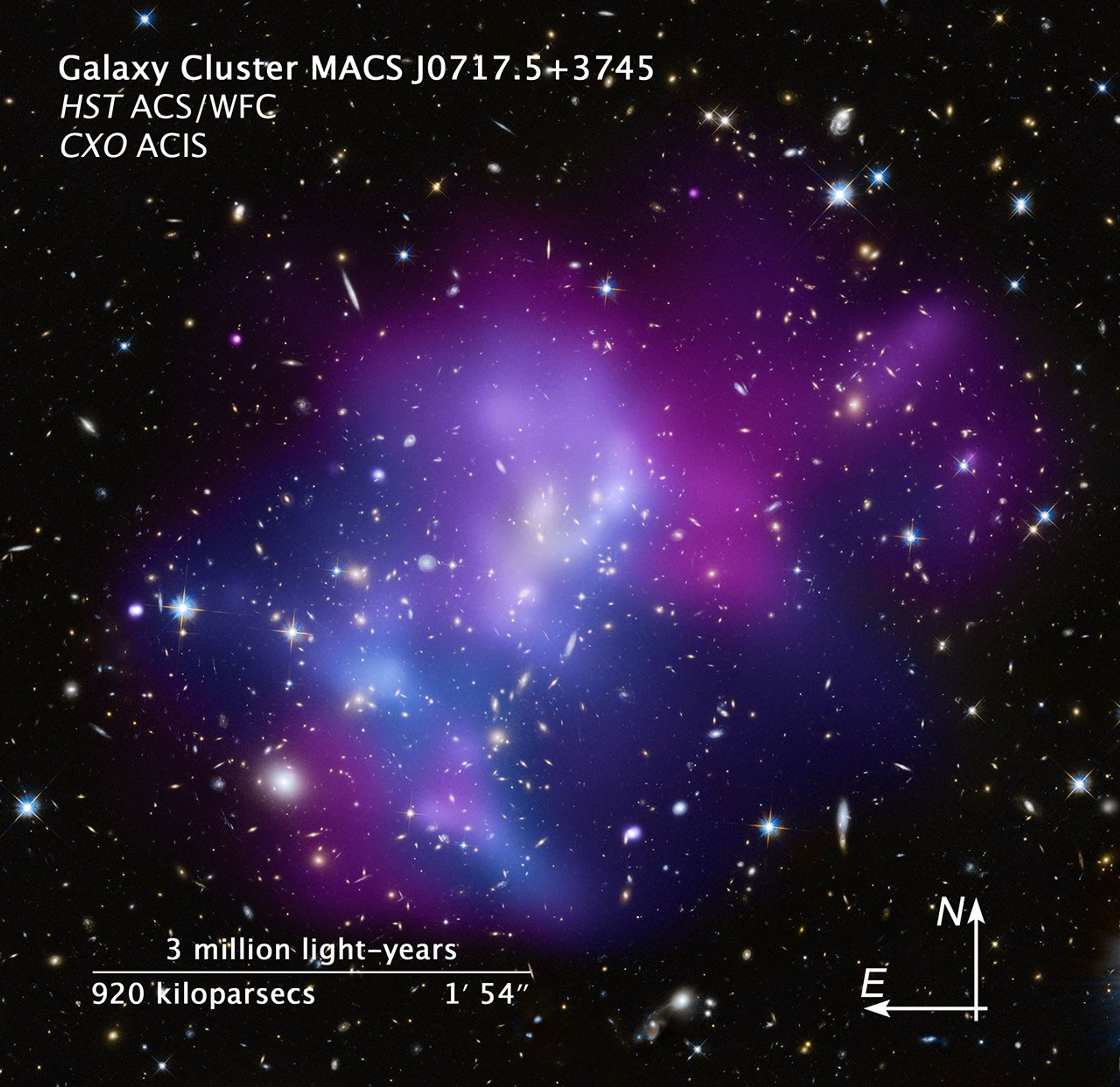1 min read
Compass and Scale Image of MACS J0717

About the Object
- R.A. PositionR.A. PositionRight ascension – analogous to longitude – is one component of an object's position.07h 17m 33.79s
- Dec. PositionDec. PositionDeclination – analogous to latitude – is one component of an object's position.37° 45' 20.01"
- ConstellationConstellationOne of 88 recognized regions of the celestial sphere in which the object appears.Auriga
- DistanceDistanceThe physical distance from Earth to the astronomical object. Distances within our solar system are usually measured in Astronomical Units (AU). Distances between stars are usually measured in light-years. Interstellar distances can also be measured in parsecs.5.4 billion light-years or 1.7 billion parsecs
- DimensionsDimensionsThe physical size of the object or the apparent angle it subtends on the sky.The image is roughly 4.5 arcminutes (7.7 million light-years or 2.4 megaparsecs) wide.
About the Data
- Data DescriptionData DescriptionProposal: A description of the observations, their scientific justification, and the links to the data available in the science archive.
Science Team: The astronomers who planned the observations and analyzed the data. "PI" refers to the Principal Investigator.Chandra Data: Chandra data used were from proposal 4200. Hubble Data: The Hubble images were created from HST data from proposal 10420: PI: Dr. H. Ebeling (University of Hawaii), I. Smail (University of Durham, UK), J.-P. Kneib (Laboratoire d'Astrophysique de Marseille, France), G. Smith (University of Birmingham, UK), and D. Donovan and E. Barrett (University of Hawaii). - InstrumentInstrumentThe science instrument used to produce the data.CXO>ACIS and HST>ACS/WFC
- Exposure DatesExposure DatesThe date(s) that the telescope made its observations and the total exposure time.January 10, 2003 (CXO) and January 24, 2005 - February 9, 2005 (HST)
- FiltersFiltersThe camera filters that were used in the science observations.ACS: F606W (V) and F814W (I) ACIS Energies: 5 - 25 T(keV)
- Object NameObject NameA name or catalog number that astronomers use to identify an astronomical object.MACS J0717.5+3745
- Object DescriptionObject DescriptionThe type of astronomical object.Cluster of Galaxies
- Release DateApril 16, 2009
- Science ReleaseGalaxy Cluster MACS J0717
- Credit

The image is a composite of separate exposures made by the ACS instrument on the Hubble Space Telescope and the ACIS instrument onboard the Chandra X-ray Observatory. Two filters were used to sample broad wavelength ranges. A continuous energy band was used to sample the X-ray data. The color results from assigning different hues (colors) to each monochromatic image. In this case, the assigned colors are: Cyan: F606W (V) Yellow: F814W (I) Blue - Violet (temperature map): 5 - 25 T(keV)

Related Images & Videos

Galaxy Cluster MACS J0717
This composite image shows the massive galaxy cluster MACS J0717.5+3745 (MACS J0717, for short), where four separate galaxy clusters have been involved in a collision – the first time such a phenomenon has been documented. Hot gas is shown in an image from NASA's Chandra X-ray...
Share
Details
Claire Andreoli
NASA’s Goddard Space Flight Center
Greenbelt, Maryland
claire.andreoli@nasa.gov




























